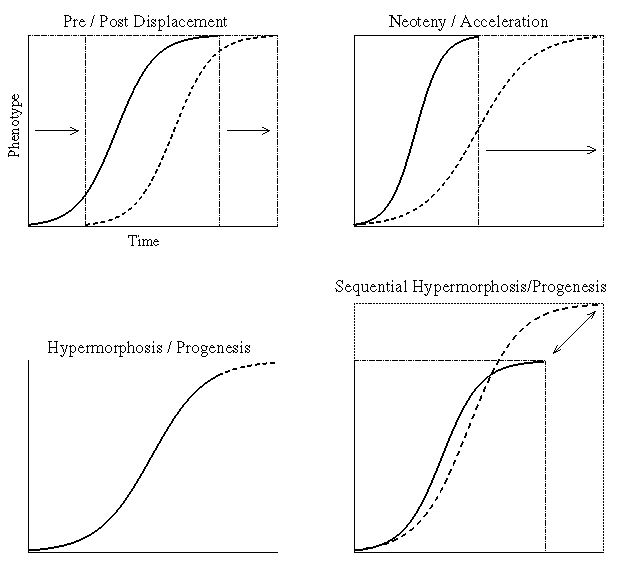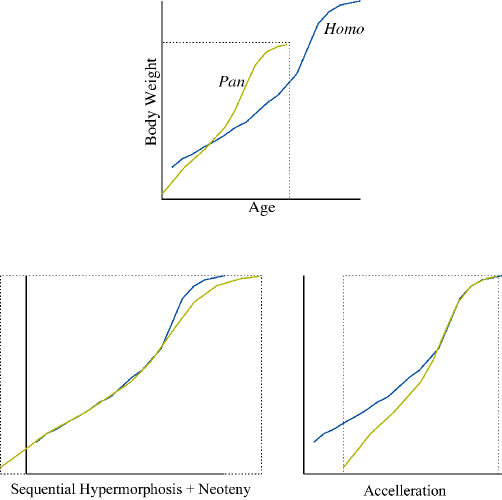
Heterochrony
Heterochrony broadly refers to changes in the rate or timing of developmental events.
For morphological traits, we can characterize a growth process as an " Ontogenetic Trajectory".
There is a whole nomenclature for different ways that an ontogenetic trajectory can change.
In the case of the Irish Elk, A new morphology resulted simply from extending the growth trajectory of the ancestor. This is an example of Hypermorphosis. Sometimes there are a series of growth phases. In this case we may see Sequential Hypermorphosis, in which each growth phase is extended to the same degree.
Recall that the converse of hypermorphosis is Progenesis
There are two other kinds of heterochrony that are often referred to:
Acceleration is an increase in the rate of
development of some part of the organism, relative to body size.
Neoteny is a slowing of development of a part relative to body size.
We can represent the different sorts of heterochrony as transformations of an "ontogenetic trajectory", which is just a plot of phenotype as a function of age.
(Note: We did not cover pre- and post-displacement in lecture, and they will not be on the exam.)

When two trajectories can be superimposed by applying some combination of these transformations to one of them, then we know that the difference between the two growth processes could be due to a uniform change in rate or timing of growth (heterochrony).
When it is not possible to so superimpose trajectories, then we know that there has been some structural change within one of the growth processes.
Heterochrony in human evolution.
If we look at overall growth, there appears to be different kinds of transformations occurring before and after the onset of puberty in humans.

Prior to the onset of puberty, the human trajectory looks like the chimp trajectory transformed with a combination of sequential hypermorphosis and neoteny.
After this point, growth is accelerated
This produces two unique aspects of human ontogeny:
1) There is an apparent "growth spurt" around puberty.
2) There is a prolonged "childhood" phase, between infancy and young adulthood.
Neither of these is seen in other primates.
Biomechanical Scaling
Many traits scale with body size even when we look across very different
organisms with very different sizes.
In such cases, the results are generally due to selection resulting
from the scaling of different physical processes.
For example, consider the skeleton of vertebrates.
Recall that area scales as linear dimension squared, while volume scales as linear dimension cubed.
The strength of a bone scales as its cross sectional area (holding shape
constant).
Bone strength thus goes up as length squared.
Thus, if two bones are the same shape but one is twice as long as the other, the longer bone is 4 times harder to break.
By contrast, the weight that the bone must hold up goes up with the
length cubed.
So a bone that is twice as long is 8 times heavier.
Thus, if we keep bone shape constant, the weight that bones must support quickly surpasses their structural integrity.
Note that 23 = 2.832
As a consequence, large animals have proportionally thicker bones than
do small animals.
Also, a larger proportion of their body mass is made up of bone.
If bone strength were to keep up with mass, bone cross sectional area would have to scale as length cubed (as mass does). In that case, bone mass would scale as cross sectional area times length, so it would scale as length to the fourth power, or as body mass to the 4/3 power.
For example, a cat's skeleton comprises about 7% of its body mass, while the skeleton of an elephant is about 13% of its body mass.
Even with this increase, an elephant is proportionally less sturdy than a cat.
Assuming that an elephant weighs about 7000kg and a cat about 5kg, then the elephant is 1400 times the size of the cat.
The cat's skeleton weighs about 5*.07 = 0.35kg. This multiplied by
14004/3 would be the weight that an elephant's skeleton would
have to be in order to be as sturdy as that of a cat.
This would be a skeleton weighing 5481kg, which would be about 78% of
the entire mass of the elephant.
In fact, for terrestrial animals, skeletal weight scales as total body
mass to the 1.083 power (rather than to the 1.333 power).
Thus, bigger animals can not jump proportionally as far as small ones.
We have been considering Vertebrates, for whom the skeleton is on the inside with the muscles on the outside.
The same principles apply to Arthropods, but here the skeleton is on the outside (comprising hollow tubes) and the muscles are in the inside.
The skeleton of an arthropod is much heavier than the skeleton of a vertebrate of the same size. This is good for very small organisms - the skeleton of an arthropod can be quite strong even if the organism is very small - but it creates problem for larger organisms.
All of this discussion assumes that we are dealing with terrestrial
animals.
For marine mammals and fish, skeletal mass scales very nearly as
body mass.
*************************************************************************
Homework Problem
For the two "organisms" shown above, calculate:
1) How much heavier is organism B than organism A?
2) How much stronger is the leg bone of organism B than that of organism A?
3) How thick would B's leg bone have to be in order for it to support B's weight as well as A's leg bone supports A's weight?
*************************************************************************
Morphological novelty
Example:
Early Synapsids had one bone in the middle ear, the columella, that extended
down to make contact with the jaw joint.
The jaw joint was an articulation between the quadrate bone (in the
upper jaw) and the articular bone (in the lower jaw).
The lower jaw had a number of bones, the largest of which was the Dentary
(which held the teeth).
In mammals, the jaw joint is between the dentary (now the only bone in the lower jaw) and the squamosal, the descendants of the quadrate and articular are the Incus and the Maleus, two new middle ear bones.
Quadrate - Incus
Articular - Malleus
Three bones in the middle ear are advantageous for amplifying vibrations. Jul 8, 2021